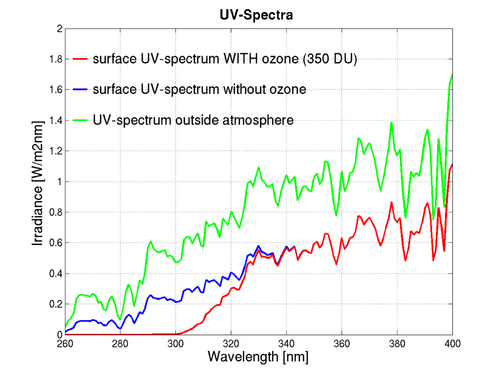The spectral distribution of solar UV radiation reaching the Earth's surface depends on the radiation emitted by the Sun, the Earth-Sun distance, the optical properties of the atmosphere, the solar elevation, and the reflection properties of the ground (surface albedo). The transmission of solar radiation in the UV-B region (280-315nm) through the stratosphere (10-50 km altitude) is primary determined by the total amount of stratospheric ozone. In the troposphere (below 10 km) the attenuation of UV-B and UV-A (315-400nm) radiation is mainly related to scattering by air molecules (Rayleigh scattering) and scattering by water or ice particles in clouds.
The figure below shows the UV spectral irradiance outside the Earth's atmosphere (green line) and at the ground (red line). The blue line illustrates the surface UV spectral irradiances in a (unrealistic) situation with no atmospheric ozone. The figure is based on calculations with a radiative transfer model.

Ozone
Ozone absorbs solar ultraviolet radiation. However, the absorption properties are strongly wavelength dependent. UV radiation is divided into three wavelength regions: UV-C (200 - 280nm), UV-B (280-315 nm) and UV-A (315 - 400 nm). UV-C radiation from the sun is completely absorbed by ozone in the atmosphere even with a strongly depleted ozone layer. The absorption in the UV-B is weaker allowing UV-B to reach the Earth surface.The instensity of the surface UV-B varies with the amount of ozone in the atmosphere. UV-A radiation is nearly insensitive to ozone variations.
Atmospheric ozone is distributed in the 0 - 50 km altitude range and the concentration varies strongly with altitude. The maximum concentration is found between 20 and 25 km. About 10 % of the total amount of ozone is found in the troposphere (below 10 km). If all ozone was brought down to the surface in a layer of pure ozone the thickness of this imaginary layer would be 2-5 mm. This corresponds to 200 - 500 DU (Dobson Units). DU is the unit for atmospheric ozone amount (i.e. ozone in a vertical column from the surface to the "top" of the atmosphere).
UV index
The UV index is a measure of the intensity of UV radiation and describes the expected risk of overexposure to the sun. The UV index accounts for UV-A and UV-B radiation and is based on the CIE action spectrum (UV Index = CIE dose in W/m2 multiplied by 40). The index predicts UV intensity levels on a scale of 1 to 11+, where 1 indicates a low risk of overexposure and 11+ signifies an extreme risk.
| UV index | Exposure level |
|---|---|
| 0 - 2 | Low |
| 3 - 5 | Moderate |
| 6 - 7 | High |
| 8 - 10 | Very high |
| 11+ | Extreme |
If the UV index is below 2 one can safely be outdoors without sun protection. For indexes above 3 exposure to the sun can cause immediate effects, such as sunburn. Protective clothing (including a hat), sunglasses and sunscreen with high SPF should be used. If the UV index is very high one should seek shade and avoid the sun during midday.
Cloud modification factor
Scattering in clouds can significantly influence the surface UV radiation. Because of the weak wavelength dependence of cloud scattering, UV-A and UV-B radiation will be more or less equally affected by clouds. Our measurements show that clouds can attenuate UV radiation more than 95% compared to a clear sky. On the other hand clouds might enhance the radiation. This can happen when the sky is partly cloudy and the solar disk itself is not covered by clouds. The cloud effect can be characterized by a simple ratio, which is the irradiance actually measured at the ground divided by the irradiance that would have been measured under a clear sky. The cloud modification factor is defined as
CMF = F340measured/F340clear
F340clear is the clear sky irradiance at 340 nm reaching a bare ground. A snow cover will increase the diffuse radiation at the surface, due to multiple reflections between the surface and the overlying atmosphere. Thus, when the ground is covered by snow the CMF can exceed the clear sky value for bare ground.